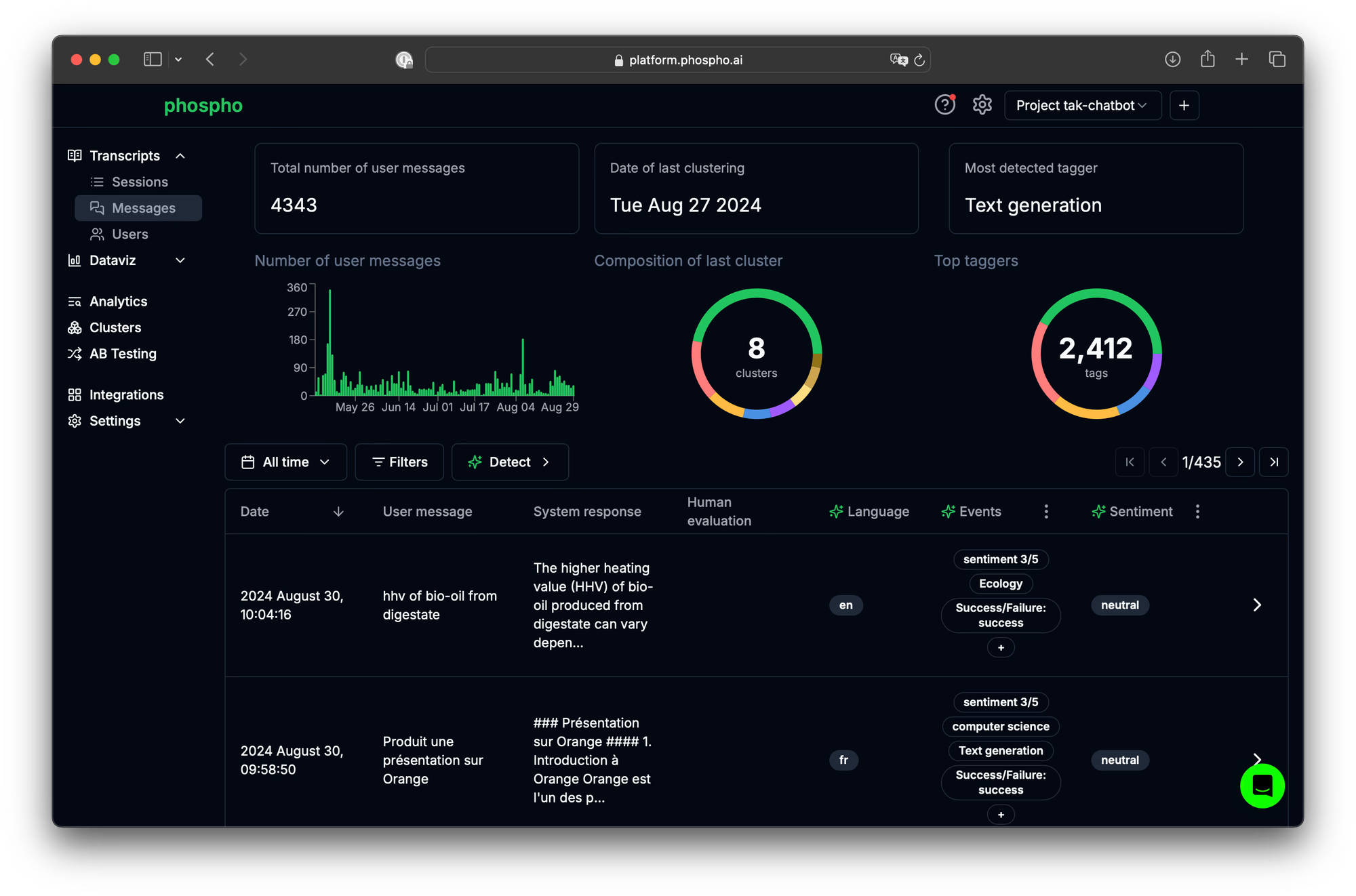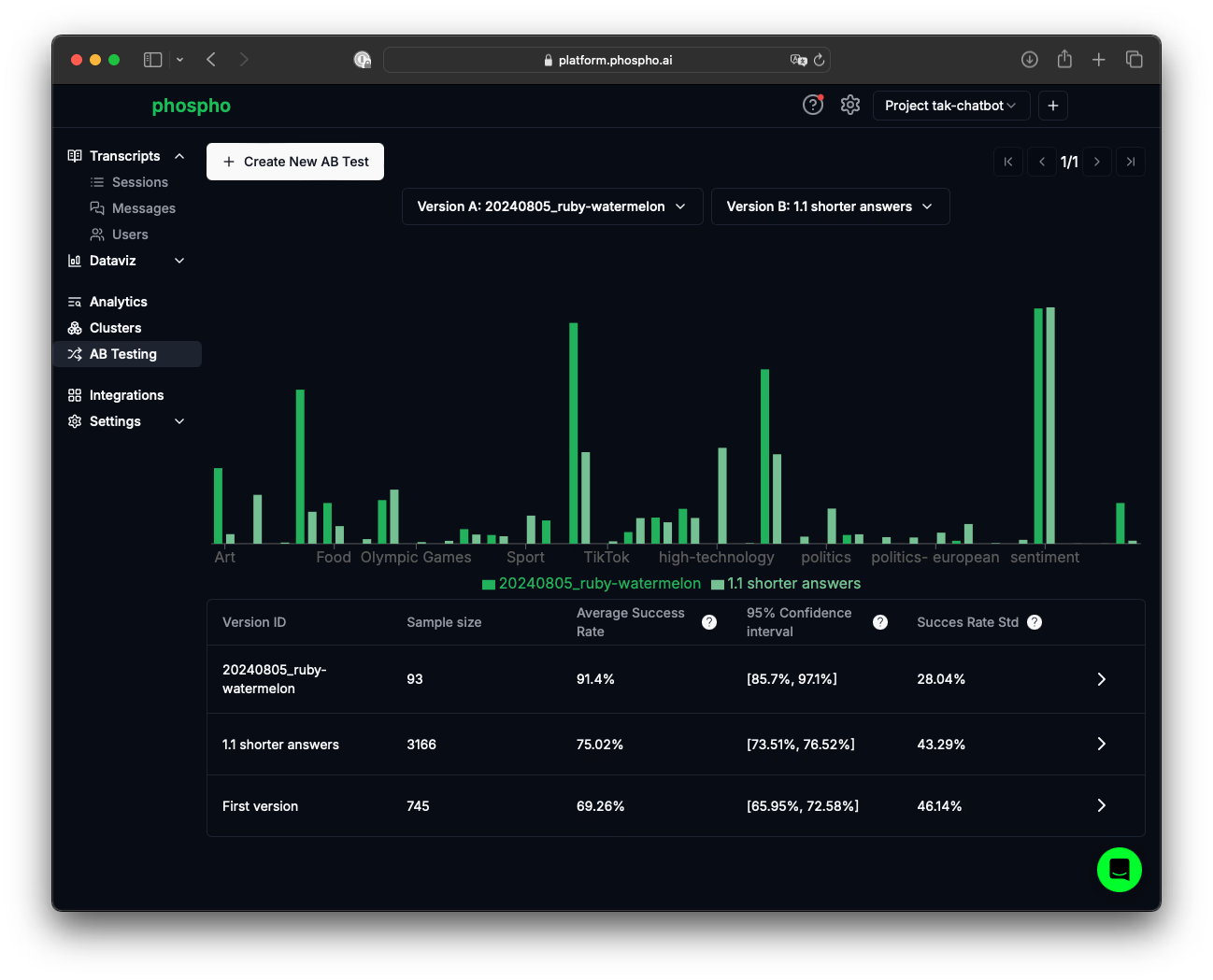The Role of Text Analytics in Improving AI Product Development
Text analytics is key in AI product development, providing real-time insights to improve user understanding and accelerate product-market fit. Phospho offers a powerful platform for AI startups to leverage text data for more efficient product iterations and reduced churn.

Exciting news, phospho is now bringing brains to robots!
With phosphobot, you can control robots, collect data, fine-tune robotics AI models, and deploy them in real-time.
Check it out here: robots.phospho.ai.
Understanding Text Analytics and Its Relevance in AI Product Development
AI has become so often integrated and widely used, that over 65% of consumers now expect to use conversational AI to communicate with everyday apps.
Why does this matter? Because these user conversations are the best feedback and data you can get…
Text analytics is how you leverage this huge amount of unstructured conversational data for:
- Faster product market fit
- Highly effective AI product development
- Sticker products with less churn
Without these insights from text analytics to deeply understand your users, most AI SaaS end up with a use case too broad and used in too many ways to find product market fit or be competitive in the SaaS market.
What is Text Analytics and Why It’s Crucial for AI Product Development?
Text analytics is a way to extract insights from unstructured text data which in our increasingly AI driven world has become more important.

Process of text analytics (simple step by step)
The process behind text analytics is simple:
- Collect Data - by logging and monitoring user interactions in real-time with analytics tools like Phospho which is made for AI SaaS products
- Data Processing - cleaning and structuring the text data so we can analyse it
- Data Optimisation - normalise, enrich, and validate data for effective use. Better data means better AI performance, lower costs, and faster development
- Data Analysis - custom KPIs and events, clustering, visualisations, identifying patterns/trends/anomalies (for actionable insights)
Important: your text data should be processed and optimised before performing analysis for more accurate and actionable insights. For an in-depth step by step guide on data optimisation for your AI SaaS read this article.
Why you need text analytics for AI product development

The value of text analytics is the competitive edge it can give you for more effective AI product development and faster product market fit by:
- Understanding real user intent (better product improvements)
- Identifying pain points and problematic edge cases (reduce churn)
- Personalising experiences (increase stickiness)
Use text analytics for data driven insights into your users and what they really value to address the broad usage issue with most AI SaaS early on and accelerate time to product market fit.
You can use Phospho for comprehensive text analytics for free by signing up here.
Or if you’re an AI SaaS startup you can claim $2000 worth of credits (Anthropic, Mistral, OpenAI, and Phospho) + a call with our amazing team to guide you in your product-market-fit journey.
You can apply here.
(Yes it’s completely free, it’s what we wish we had when we started!)
Common Challenges in AI Product Development Without Text Analytics
In the competitive market of AI SaaS, data is the new gold.
Understanding your users is what underpins:
- More effective iteration of your product
- Finding product market fit
The challenges with AI product development is obtaining data for this and whether we can extract actionable insights from it.
Data Overload
Conversational AI creates massive amounts of valuable data from user conversations but they’re unstructured, large in volume, and hard to extract insights from without text analytics.
If you’re not even collecting this data at all yet, try using Phospho for real time analytics on user interactions - read more here.
Poor User Experience
To have a good user experience and sticky users, you need to understand their intents, sentiment, and engagement across your AI product. Without text analytics to gather this understanding, you risk developing without alignment to your users real needs and preferences.
Lack of Focus in Conversational AI
Without monitoring user interactions with text analytics, it’s also hard to understand or visualise with any certainty how your users are engaging with your AI. Text analytics provides clarity over different use cases to focus on for increased stickiness and engagement which are important for finding product market fit.
Find out why text analytics is the key to a successful LLM app in 2024 here.
How Text Analytics Helps Overcome These Challenges
The biggest growth lever behind addressing these challenges is extracting actionable insights for more effective iteration cycles towards product market fit.

Real-Time User Insights
Real-time data is the most actionable and provides the highest ROI. This is because any real-time insights will have much higher relevance and impact on your users than retrospective data which is what you are limited to with traditional analytics tools.
Find out why AI SaaS cannot depend on traditional analytics in 2024.
Better Model Training and Optimisation
Text analytics with Phospho goes further than logging user interactions in real-time. You can also define and track custom KPIs with complete flexibility to help developers zero in on any specific aspects of performance to optimise. This level of freedom and specificity combined with real-time insights ensures you always iterate towards improved user experiences.
Rich Understanding of Use Cases
Text analytics helps to visualise performance across different use cases as well as identify edge cases and niche scenarios. By understanding how your product is used, you can fine tune and optimise your product for specific user segments or needs. Or you can investigate edge cases further by applying custom KPIs against them to better inform any necessary next steps.
The best way to see how Phospho can do this with your AI product is with our guided example walkthrough showcasing its practical application.
Phospho’s Text Analytics Solution: Driving Innovation in AI Product Development
Phospho is an open-source text analytics platform specifically designed to meet the needs of AI SaaS startups in a way that traditional analytics tools are not.
Here’s a quick non exhaustive list of its key features:
- Real-Time Monitoring: This lets you track and log user inputs to identify issues or trends and continuously fine-tune the performance of your LLM app.
- Custom KPIs (for any use cases): Create your own KPIs and custom criteria to ‘flag’ for, and you can label whether it was a successful or unsuccessful interaction.
- Continuous Evaluation: use our automatic evaluation pipeline that runs continuously to keep improving your model’s performance.
- Easy Integration: simply add Phospho to your tech stack with any popular tools and languages like JavaScript, Python, CSV, OpenAI, LangChain, and Mistral.
- User Feedback Linking: collect, attach, and analyze user feedback in context to make targeted improvements toward overall app performance.
How We Used Phospho To Increase Retention by 25%
Earlier this year, we created Tak, our own AI search engine and used Phospho’s text analytics to:
- Understand the most popular use cases
- Cluster search queries and topics
- Identify the most common pain points in real-time
After launching a new version with these insights our users came back stronger than ever. As user satisfaction increased, so did retention by around 25%!

See how Phospho’s clustering tool helped reduce churn and boost engagement for TAK, our AI search engine here: Read Article.
Put simply, text analytics will help you find product-market fit faster, upsell power users, and scale your AI product. Start leveraging text analytics for free with Phospho here.
(If you’re an eligible AI SaaS startup, apply to our free startup program and get $2000 free LLM and Phospho credits).
Conclusion: The Future of AI Product Development with Text Analytics
Speed is becoming more of a differentiating factor in the AI market. And by speed we mean the rate at which you can iterate WITH informed decisions.
That’s why real-time insights are necessary today for AI product development - traditional analytics tools simply won’t cut it. You need real-time analytics tools like Phospho which is specifically designed for optimising LLM apps.
Want to take AI to the next level?
At Phospho, we give brains to robots. We let you power any robot with advanced AI – control, collect data, fine-tune, and deploy seamlessly.
New to robotics? Start with our dev kit.
👉 Explore at robots.phospho.ai.
